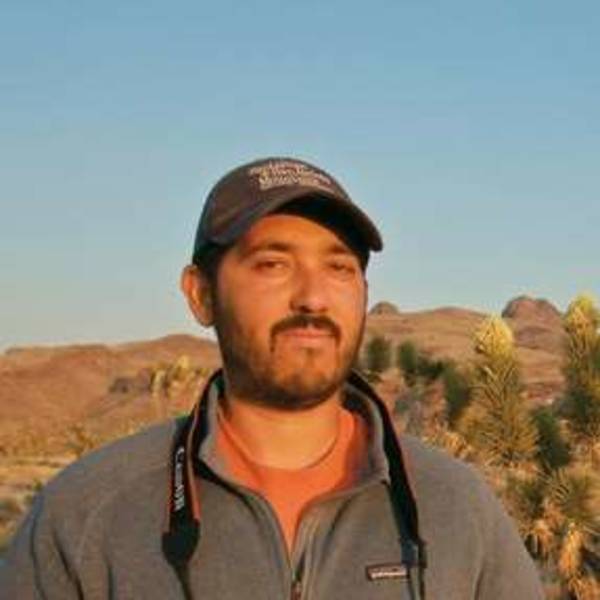We are driving east on a rugged powerline road in Clark Mountain’s shadow. The 8,000-foot peak is covered in snow. Pinyon-juniper forest commands the windshield view, with Joshua tree woodland in the rearview. As we negotiate the rocky pass with its perilous drop-off, we see the shimmering dry lakebed of Ivanpah Valley encircled by tall mountain peaks.
We get out of the truck. From this viewpoint, all I can see is Mojave National Preserve and three wilderness areas. My passenger is a botanist by training, who marvels at the diversity of cacti: beavertail, barrel, calico, cotton-top, foxtail, fishhook, and mound, until she finds a unique agave with a limited range in California. Botanists are excited by these things. I know this plant as well, one of the smallest agaves. June hikes in the Clark Mountains feature the explosion of their 10-foot flowering stalks, which are attended by a range of insects and hummingbirds, and serve as lookout towers for desert spiny lizards.
This experience contrasts with the intention of my first trip here. I came to the Clarks in 2008 to understand the visual impacts of the proposed Ivanpah Solar project to Mojave National Preserve. This valley is at an ecological crossroad, intersected by a political crossroad. We will decide this valley’s long-term fate in the next few years.
The Ivanpah Valley is a biologically diverse region and home to important desert tortoise migration corridors connecting populations in southern Nevada with those in California’s Mojave National Preserve. Unfortunately, it is also ground zero for the nascent solar energy industry. Companies have started building industrial-scale solar projects and are proposing even more for those precise Bureau of Land Management (BLM) areas. Projects currently underway include Ivanpah Solar (3,400 acres) and Silver State North (600 acres). Projects proposed for construction include Silver State South (2,900 acres) and Stateline (2,000 acres). Approval and construction of these proposed projects would sever migration corridors for the federally threatened desert tortoise. Coupled with other proposed projects such as the upgrade of the El Dorado transmission line, development of a high speed rail line, an agricultural check station, and a new Ivanpah International Airport, these projects would completely build out the valley. Such development puts the region’s immense scenery, iconic species such as the desert tortoise, and biological and cultural resources at risk. The National Parks Conservation Association is speaking out against further development in this valley, but is only as strong as the sum of its supporters. We need your help.
Of course, solar energy in itself can be a very good thing. The problem, like with any development, is where and how these arrays are built. These proposed developments should be weighed cumulatively, in terms of their impact to wildlife, scenic vistas, water resources, recreation, tourism, and their cost to local communities. Taxpayers will subsidize grants, loans, and tax incentives for industry, while footing the bill to recover the threatened species harmed by such development. Species that forage and migrate within the Ivanpah Valley will also be affected. Unmitigated impacts will continue to Mojave National Preserve, the third-largest National Park Service unit in the lower 48 states, which receives more than 600,000 recreational visits per year and contributes more than $12 million in annual visitor spending to local economies. Viewscapes, reported as one of the top visitor attractions at the preserve, will also be marred, from the mountain-top views throughout the northern preserve to the Clark Mountain Wilderness which stands above Ivanpah Solar.
Fortunately, advocates have fiercely defended the Ivanpah Valley, and local, regional, and national groups including the National Parks Conservation Association continue to speak out to save the valley.
Becoming involved with the public process and submitting written comments are some of the best ways to share your voice with decision makers.
- Contact the California (951.697.5200) and Nevada (702.515.5173) BLM offices to voice your opinion about protections for national parks and preserves and responsible energy development.
- Submit public comment on the Desert Renewable Energy Conservation Plan (DRECP) in person or online at drecp.org. This forum seeks input from the public, desert counties, the state, and the federal government. Send your feedback to DRECP Program Managers Vicky Campbell (916-978-4320) and Scott Flint (916-651-3774).
- Contact Secretary of the Interior Ken Salazar at 202-208-3100 or feedback@ios.doi.gov to voice your opinion about protections for national parks and preserves.
A version of this story was recently published in The Sun Runner magazine.
About the author
-
 David Lamfrom Vice President of Regional Programs
David Lamfrom Vice President of Regional ProgramsDavid, the Vice President of Regional Programs, uses his passion and knowledge of our natural, cultural and historical resources to inspire others to learn about and protect our national parks.


